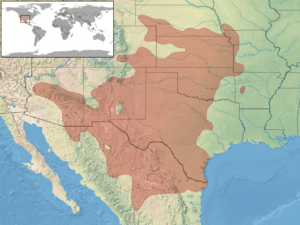Great Plains skink facts for kids
Quick facts for kids Great Plains skink |
|
|---|---|
 |
|
| Conservation status | |
| Scientific classification | |
| Genus: |
Plestiodon
|
| Species: |
obsoletus
|
 |
|
| Synonyms | |
|
|
The Great Plains skink (Plestiodon obsoletus) is a type of lizard that lives only in North America. It's known for its interesting colors and how it cares for its eggs.
Contents
About the Great Plains Skink
The Great Plains skink is one of the biggest skinks in its group, Plestiodon. It can grow to be about 9 to 13 centimeters (3.5 to 5 inches) long from its nose to the start of its tail. If you include its tail, it can be almost 34 centimeters (13 inches) long!
This lizard usually has a light gray or beige body. Its back scales have cool black or dark brown edges. The scales on its sides go in a diagonal pattern. Its belly is a bright yellow color. Young skinks look very different! They are black with white spots on their lips and head. They also have a bright blue or bluish tail.
Where Great Plains Skinks Live
You can find the Great Plains skink all over the Great Plains. Their home stretches from southeastern Wyoming and Nebraska (and even a small part of Fremont County, Iowa). They live south through eastern Arizona and Texas, reaching into Mexico.
Great Plains Skink Habitat
These skinks like to live in open plains or the eastern foothills of the Rocky Mountains. They often choose areas close to water, like irrigation ditches. In southeastern Colorado, you might find them up to about 1,900 meters (7,200 feet) high. But in northern Colorado, they usually stay below 1,400 meters (4,500 feet).
Reproduction and Life Cycle
The Great Plains skink's mating season happens in April or May. In early summer, the female skink lays her eggs. She can lay anywhere from 5 to 32 eggs, but usually it's about 12. She stays with her eggs and guards them carefully until they hatch in late summer.


